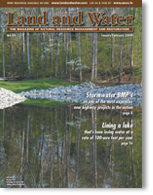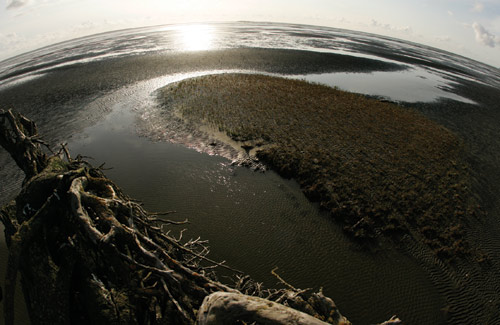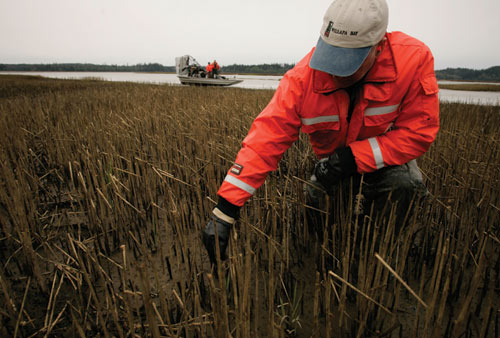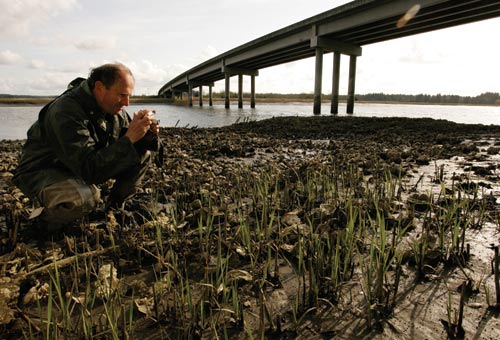Invasive Spartina Infiltrates the WestGroups fight to save west coast estuaries |
A Battle 100 Years in the Making Spartina, an invasive cordgrass that’s not native to the west coast, is believed to have arrived in Willapa Bay in the late 1800s with oysters from the east coast. During the next 100 years, the plant invaded the tidal mudflats of Willapa Bay and currently infests up to 32 percent of the bay, destroying habitat for native plants and wildlife and threatening the important flyway used by migratory shorebirds. In addition, Spartina eliminates shellfish seed beds, threatening the $30 million local shellfish industry. Farther south, San Francisco Bay is facing 35 years of Spartina infestation. Initially thought to be beneficial, the plant was brought to San Francisco Bay in the 1970s as part of a shoreline stabilization project – and the non-native Spartina quickly spread through the bay. According to a report by the California Coastal Conservancy’s San Francisco Estuary Invasive Spartina Project, from 2000 to 2003 Spartina expanded from 470 acres to about 2,000 acres of the bay’s tidal marshes and mudflats.1 With seeds that are easily transported by migratory birds and on the tide, Spartina also threatens the ecological well-being of other estuaries along the west coast, which provide vital winter habitat to thousands of shorebirds, including the endangered California clapper rail, snowy plover and upland sandpiper. To defend west coast estuaries against Spartina, a number of groups have waged war on the weed, but they’re in the middle of a long, tough battle.
Profile of the Enemy The Value of Mudflats Endangered birds like the California clapper rail need open mudflats for feeding and cannot use dense Spartina patches. The thick Spartina patches also have an adverse affect on many species of fish and shellfish. As the dense masses of Spartina create meadows above the mudflats, fish only have access to intertidal habitat during the highest tides. As a result, fish and shellfish have limited access to the nutrient-rich waters known as the “nurseries of the sea” that provide spawning habitat for many species. UC Davis researcher Dr. Elizabeth Brusati found that Spartina may be so dense that even the smallest organisms, which are an important food source for both fish and shorebirds, cannot find space to live within thick Spartina patches.2 These nurseries of the sea are also an important foundation for the west coast shellfish industry. Oystermen have been a part of Willapa Bay since the late 1840s, relying on the mudflat oyster beds for their livelihood. Today, nearly 20 percent of the nation’s oysters are produced in Willapa Bay. Oystermen were also some of the first people to recognize that something was wrong in Willapa Bay. According to Dick Sheldon, who has owned and operated Willapa Bay’s Northern Oyster Company since the mid-1960s, in the late 1970s oystermen began noticing grass patches on the mud around their oyster beds. As the patches spread, they realized that the grass – Spartina – was taking over the oyster beds. According to Sheldon, a 90-acre oyster seed bed is worth $40,000. Infested with Spartina, it’s worth about $900. By the early 1990s, Sheldon and a number of people from various agencies began working on a solution for the growing problem in Willapa Bay. By far one of the most effective ways Sheldon helped tackle Spartina was by giving newly transplanted Washington State University researcher Dr. Kim Patten a ride around Willapa Bay in his boat. Dr. Kim Patten came to Washington as a cranberry researcher for Washington State University and saw a huge problem in his back “bay” so to speak – Spartina. Along with the staff of the wildlife refuge and other local groups, Dr. Patten took on the tough job of defending the bay from Spartina. Within a year of his arrival in the Willapa Bay area, Dr. Patten, Sheldon and others attended the International Spartina Conference to discuss the Spartina issue, concerns and possible solutions. While there was a lot of talk at the conference, there was very little action. Dr. Patten’s initial chemical research was done with glyphosate in the early 1990s, but the chemical’s effectiveness was variable and application rates were fairly high. In 1997, research out of New Zealand showed promising Spartina control from some new herbicides. From 1997 to 2002, Dr. Patten researched the new herbicide – Habitat® herbicide – including its efficacy, toxicity, effects on native vegetation and herbicide fate and persistence. He found that it presented little to no risk to the environment and controlled the Spartina. By 2001, Dr. Patten’s research began getting attention. Along with his efforts, organizations like the Olympic Natural Resource Center, Willapa Grays Harbor Oyster Growers Association, Pacific County Board of Commissioners and Noxious Weed Control Board, The Nature Conservancy, Ducks Unlimited, Willapa National Wildlife Refuge, and the Washington Departments of Agriculture, Natural Resources and Fish and Wildlife all worked together on a partnership with legislators and regulatory agencies to form the Comprehensive Unified Spartina Eradication Plan. This plan was enacted in 2002 and provides the bay and its protectors with much-needed funding – to the tune of $2 million a year for six years – to wage a full-scale war on Spartina.
“Our efforts resulted in the development and implementation of the only effective tool currently available for Spartina control,” said Patten. “In 2004, the first year of estuarine registration, this new herbicide was used on 6,000 acres of Spartina. This resulted in a six-fold increase in control over the previous five years’ combined effort to control Spartina.” About 5,500 acres of Spartina were treated during 2005. While the control results have been impressive, Patten stresses that they are still fine-tuning the control program. But there is reason to be optimistic. For the first time in 15 years there’s been significant progress toward eradication of Spartina in Willapa Bay. And after two years under the eradication plan, the most telling result comes from reports by the U.S. Fish and Wildlife personnel at Willapa Bay’s wildlife refuge. As many as 10 species of shorebirds have been spotted in the refuge that had disappeared two years ago. Willapa Bay’s struggle with Spartina and relatively recent success has contributed to exciting developments on the southern front of the war. Efforts to control Spartina in San Francisco Bay began in 2003 and are coordinated by the Coastal Conservancy’s Invasive Spartina Project. Just as in Willapa, early mechanical methods of control worked for small areas but couldn’t compete with the spread of the weed. “The consensus among researchers is that the problem in California is manageable, but must be acted upon quickly before San Francisco Bay looks like Willapa Bay,” said researcher Elizabeth Brusati.2 “Removing the extensive infestations requires the use of herbicide.” The Invasive Spartina Project has used glyphosate to try to control Spartina in San Francisco Bay, but according to Erik Grijalva, Field Operations Manager, Invasive Spartina Project, glyphosate simply doesn’t have the efficacy to control the spread of Spartina, which is expanding at more than 100 percent a year in the bay. Looking for a better control option, the Invasive Spartina Project obtained a California Department of Pesticide Research Authorization in 2004 to use Habitat herbicide on 65 acres in some of the bay’s flood channels. For the most part, the Spartina control on the channel areas sprayed was the greatest efficacy seen bay-wide, said Grijalva. A big boost to the Invasive Spartina Project’s efforts came in August 2005 with the registration of the herbicide for state-wide use in California, which allows Spartina control efforts to expand to the entirety of the bay’s infestation – not just a small research area. “In light of this registration, our plans are to use the herbicide almost exclusively for Spartina control in San Francisco Bay because we’re able treat the entire infestation and use a lot less chemical,” said Grijalva. “Without the full registration, it would have been extremely difficult for us to pursue a large scope of treatment effort in the bay.” By 2010 the Invasive Spartina Project hopes to eliminate Spartina completely from the bay, which will be a major victory for not only San Francisco Bay, but the entire west coast. For more information contact John Smith, BASF ProVM Sales Specialist (503) 510-1123, email: smithjh@basf.com.
|
©2006 - 1998 Land and Water, Inc.




